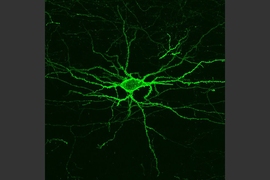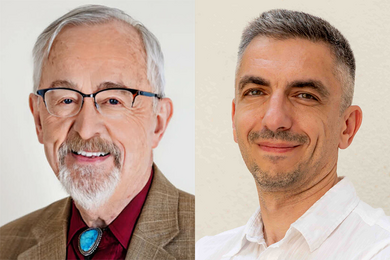Ed Boyden, the Y. Eva Tan Professor in Neurotechnology at MIT has been named a recipient of the 2018 Canada Gairdner International Award — Canada’s most prestigious scientific prize — for his role in the discovery of light-gated ion channels and optogenetics, a technology to control brain activity with light.
Boyden’s work has given neuroscientists the ability to precisely activate or silence brain cells to see how they contribute to — or possibly alleviate — brain disease. By optogenetically controlling brain cells, it has become possible to understand how specific patterns of brain activity might be used to quiet seizures, cancel out Parkinsonian tremors, and make other improvements to brain health.
Boyden is one of three scientists the Gairdner Foundation is honoring for this work. He shares the prize with Peter Hegemann from Humboldt University of Berlin and Karl Deisseroth from Stanford University.
“I am honored that the Gairdner Foundation has chosen our work in optogenetics for one of the most prestigious biology prizes awarded today,” says Boyden, who is also a member of MIT’s McGovern Institute for Brain Research and an associate professor in the Media Lab, the Department of Brain and Cognitive Sciences, and the Department of Biological Engineering at MIT. “It represents a great collaborative body of work, and I feel excited that my angle of thinking like a physicist was able to contribute to biology.”
Boyden, along with fellow laureate Karl Deisseroth, brainstormed about how microbial opsins could be used to mediate optical control of neural activity, while both were students in 2000. Together, they collaborated to demonstrate the first optical control of neural activity using microbial opsins in the summer of 2004, when Boyden was at Stanford. At MIT, Boyden’s team developed the first optogenetic silencing (2007), the first effective optogenetic silencing in live mammals (2010), noninvasive optogenetic silencing (2014), multicolor optogenetic control (2014), and temporally precise single-cell optogenetic control (2017).
In addition to his work with optogenetics, Boyden has pioneered the development of many transformative technologies that image, record, and manipulate complex systems, including expansion microscopy and robotic patch clamping. He has received numerous awards for this work, including the Breakthrough Prize in Life Sciences (2016), the BBVA Foundation Frontiers of Knowledge Award (2015), the Carnegie Prize in Mind and Body Sciences (2015), the Grete Lundbeck European Brain Prize (2013), and the Perl-UNC Neuroscience prize (2011). Boyden is an elected member of the American Academy of Arts and Sciences and the National Academy of Inventors.
“We are thrilled Ed has been recognized with the prestigious Gairdner Award for his work in developing optogenetics,” says Robert Desimone, director of the McGovern Institute. “Ed’s body of work has transformed neuroscience and biomedicine, and I am exceedingly proud of the contributions he has made to MIT and to the greater community of scientists worldwide.”
The Canada Gairdner International Awards, created in 1959, are given annually to recognize and reward the achievements of medical researchers whose work contributes significantly to the understanding of human biology and disease. The awards provide a $100,000 (CDN) prize to each scientist for their work. Each year, the five honorees of the International Awards are selected after a rigorous two-part review, with the winners voted by secret ballot by a medical advisory board composed of 33 eminent scientists from around the world.









